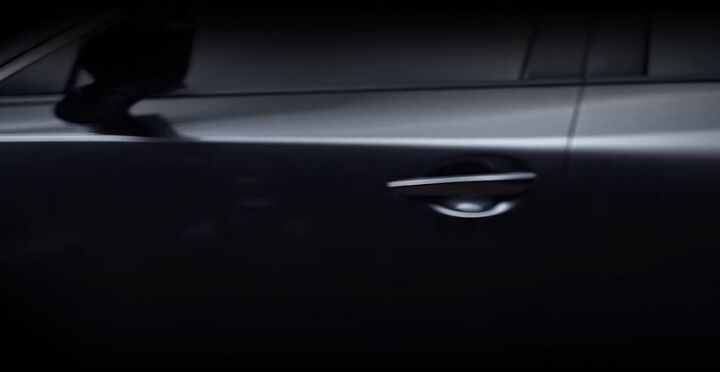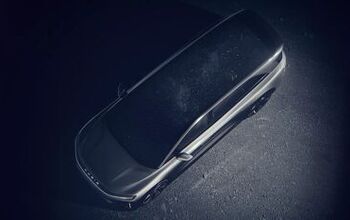Teaser Vid Heralds a New Mazda 3 and a New Way to Burn Gasoline

“A new era begins” in November, Mazda’s YouTube video announces, but the automaker is likely referring to more than just the car seen in the teaser.
The next-generation Mazda 3, snippets of which can be seen in both hatchback and sedan form, will be joined by a new gasoline engine that’s far more monumental than any revamped compact car.
As you can see from the link, there’s not to actually see, though the hatch’s severely sloped rear calls to mind the brand’s Kai concept, released last year. It was assumed at the time that the Kai would serve as inspiration for the 2019 Mazda 3. In the video’s side-on peek, the new vehicle’s flanks appear not quite as featureless; however, it’s clear the highly accentuated fender bulges of years past will soon be a thing of the past.
The date listed in the video points to a product unveiling at next month’s L.A. Auto Show, so that’s something to look forward to. This author, as well as other TTACers, remain fans of the current-gen 3 — specifically the 2.5-liter/six-speed GT version. It’s a fun little front-driver that enthusiastically and capably eats up twisty back roads, and its KODO design language earns two thumbs way up.
Whatever the 2019 model’s looks, the most radical change will lie under the hood. The new 3 serves as the first application of Mazda’s Spark Controlled Combustion Ignition (SPCCI) engine — a high-compression 2.0-liter four-cylinder that blends characteristics of both gasoline spark ignition and diesel compression ignition for greater efficiency and power.
To overcome inherent problems with gasoline compression ignition (temperature-related pre-ignition or lack of any ignition), Mazda kept a source of spark in the combustion chamber. It calls the new mill the Skyactiv-X.
Located in close proximity to the injector, the spark plug ignites only a small burst of fuel injected near the end of the compression stroke, right as the piston reaches the top of its travel. The resulting burn from this small, localized charge increases pressure in the cylinder, resulting in the combustion ignition of a pre-existing fuel-air mix that wasn’t concentrated enough to ignite on its own. This leads to a more diesel-like power signature and greater fuel efficiency.
Despite having a plan for electrification, Mazda remains of the few automakers without a hybrid or electric vehicle in its lineup. The investment in SPCCI was seen as a way of lengthening the gasoline engine’s lifespan while also making nice with the EPA. Assuming Mazda worked out all the bugs, the new tech stands to create a cheaper and less complex high-MPG vehicle.
[Images: Mazda/ YouTube]

More by Steph Willems
Latest Car Reviews
Read moreLatest Product Reviews
Read moreRecent Comments
- Kjhkjlhkjhkljh kljhjkhjklhkjh I'd rather they have the old sweep gauges, the hhuuggee left to right speedometer from the 40's and 50's where the needle went from lefty to right like in my 1969 Nova
- Buickman I like it!
- JMII Hyundai Santa Cruz, which doesn't do "truck" things as well as the Maverick does.How so? I see this repeated often with no reference to exactly what it does better.As a Santa Cruz owner the only things the Mav does better is price on lower trims and fuel economy with the hybrid. The Mav's bed is a bit bigger but only when the SC has the roll-top bed cover, without this they are the same size. The Mav has an off road package and a towing package the SC lacks but these are just some parts differences. And even with the tow package the Hyundai is rated to tow 1,000lbs more then the Ford. The SC now has XRT trim that beefs up the looks if your into the off-roader vibe. As both vehicles are soft-roaders neither are rock crawling just because of some extra bits Ford tacked on.I'm still loving my SC (at 9k in mileage). I don't see any advantages to the Ford when you are looking at the medium to top end trims of both vehicles. If you want to save money and gas then the Ford becomes the right choice. You will get a cheaper interior but many are fine with this, especially if don't like the all touch controls on the SC. However this has been changed in the '25 models in which buttons and knobs have returned.
- Analoggrotto I'd feel proper silly staring at an LCD pretending to be real gauges.
- Gray gm should hang their wimpy logo on a strip mall next to Saul Goodman's office.



































Comments
Join the conversation
Engine tech reminds me a little of Honda's stratified charge CVCC engines. That was clean, efficient, no-catalytic-converter-needed wonder technology for the otherwise malaise-ish 1970s. Wonder why Honda never followed up on those.
I certainly hope we get an electric Mazda with rotary range extender. Great application for a smooth, compact rotary. Of course, rotaries are neither clean-burning nor fuel-efficient, so the car would be green only on battery power, so hopefully they could wedge enough battery in there for 70-150 miles on EV.